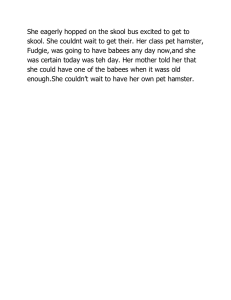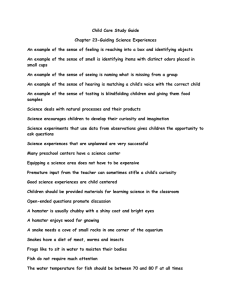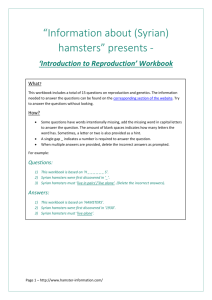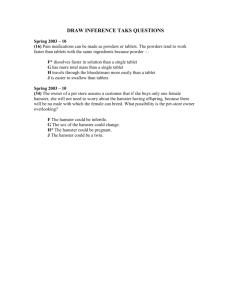How to take care of your hamster
advertisement
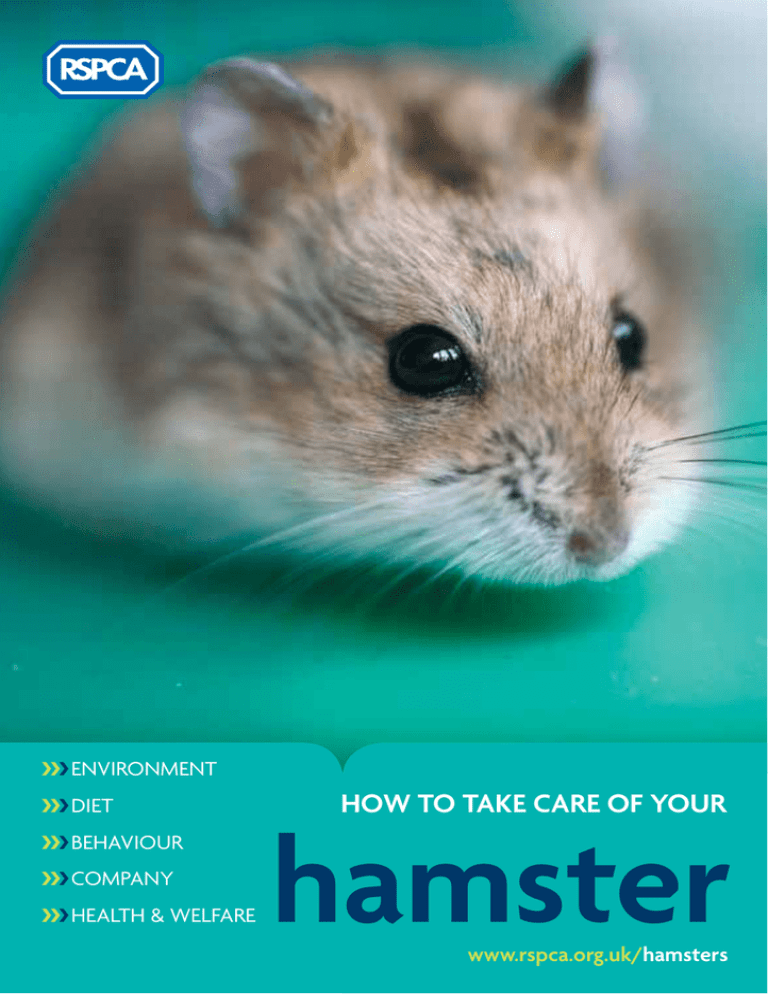
��� ENVIRONMENT ��� DIET ��� BEHAVIOUR ��� COMPANY ��� HEALTH & WELFARE HOW TO TAKE CARE OF YOUR hamster www.rspca.org.uk/hamsters HOW TO TAKE CARE OF YOUR hamster Keeping your hamster healthy and happy Owning and caring for a hamster can be great fun and very rewarding, but it’s a big responsibility and a long-term commitment in terms of care and cost – typically, hamsters live for around two years. Hamsters are often a child’s first pet because they are small animals with a great deal of character – but their needs are quite complex and they can be easily injured as a result of rough or careless handling. An adult should always be responsible for ensuring hamsters are properly handled and cared for – looking after a hamster is too much responsibility for a child. If you own or are responsible for a hamster, even on a temporary basis, you are required by law to care for him/her properly. Hamsters are nocturnal so they spend most of the day sleeping and become active in the evening and at night. This means they can make good pets for people that may be out during the day and at home during the evening, but are less suitable for young children who go to bed early. 2 WHAT YOUR HAMSTER NEEDS There is no one ‘perfect’ way to care for all hamsters because every hamster has their own personality and preferences. It is up to you how you look after your hamster, but you must take reasonable steps to ensure that you look after all their needs including a warm, safe indoor home. Under the Animal Welfare Act, pet owners are now legally obliged to care for their pets properly – as most owners already do – by providing the following five basic welfare needs. 1 A suitable place to live. 2 A healthy diet, including fresh clean water. 3 The ability to behave normally. 4 Appropriate company, including any need to be housed with, or apart from, other animals. This booklet will help you to find out more about what your hamster needs to stay healthy and happy. 5 Protection from pain, suffering, injury and disease. Contents 4 Environment / 6 Diet / 8 Behaviour / 10 Company / 12 Health & welfare WHAT YOUR HAMSTER NEEDS 3 Environment MAKE SURE YOUR hamster HAS A SUITABLE PLACE TO LIVE Hamsters need a comfortable, dry, draught-free, clean place to live, in a quiet place where they can rest undisturbed. Make sure the lights go off at approximately the same time each night. Hamsters are very sensitive to high frequency sounds (known as ultrasound) which we cannot hear, and can find this stressful. House your hamster away from items in the home which can generate ultrasound, such as television sets, computer screens, vacuum cleaners or sources of running water. Home comforts Your hamster’s cage should be safe from hazards (like sharp metal or gaps they could get stuck in) and secure, as hamsters can easily escape from poorly constructed cages! Hamsters need a lot of room – especially when they are active at night – so buy as big a cage as possible, ideally with a deep plastic base (minimum 3-5cm) and wire top. A multi-level cage will allow your hamster to climb and make the most of the space in his/her cage and you can place tunnels and toys in it for your hamster to explore. Wire sides will allow them to climb around the bars of the cage – a favourite pastime and great exercise! 4 WHAT YOUR HAMSTER NEEDS Hamsters really enjoy burrowing so provide a thick layer of litter/bedding material in the deep base of the cage. This can be dust-free wood shavings or granulated corn-cob, but check the material is free of harmful preservatives or other chemicals. Straw should not be used in your hamster’s cage because the tough strands can hurt his/her cheek pouches. Coarse sand can be used as an alternative litter option. ��� Check out www.rspca.org.uk/ hamsters/environment for lots of further tips on hamster homes. Peace and quiet You also need to provide your hamster with a nesting box or shelter in the cage to retreat to, keep warm, feel safe and sleep in. A shelter should be big enough for your hamster to store food placed nearby, make a nest and comfortably move around. It should be dark inside – some have an entrance via an angled tube to prevent light entering. It’s better if the shelter doesn’t have a floor but just rests on top of the nesting material so that you can check your hamster(s) just by lifting the shelter. A tinted red plastic shelter will appear very dark to a hamster but you will be able to see in without disturbing them. Hamsters should have enough nesting material nearby to make a proper, cup-shaped nest. Suitable materials are good-quality hay, wood wool, shredded paper or cardboard – avoid using materials that can separate into thin strands such as cotton wool or similar ‘fluffy’ bedding products because these can get caught around the hamster’s toes or feet. Housekeeping Make sure your hamster’s cage is kept clean with dry litter/bedding and nesting materials, but try to avoid disturbing your hamster’s home too often as this can be stressful. Your hamster’s litter/bedding material shouldn’t be allowed to become damp or very smelly, but remember that hamsters communicate using smells so always transfer back a small amount of old unsoiled nesting material when you clean out your hamster’s cage, especially if you have a group of hamsters living together. Clean or replace objects soiled by faeces (poo), and do not transfer litter when cleaning out the cage, as both faeces and urine on the litter contain odours that may trigger fighting. Holiday time If you are going away, make sure your pets are cared for by somebody who is responsible and who you trust. Give that person all the information they need to care for your hamster(s), keep them in their familiar cage and leave their usual food for the carer to feed them. ��� Transporting hamsters is very stressful for them so avoid this unless it’s absolutely necessary – find out more about Transporting your hamster and reducing related stress at www.rspca.org.uk/hamsters/ environment. WHAT YOUR HAMSTER NEEDS 5 Diet MAKE SURE YOUR HAMSTER HAS A HEALTHY DIET To stay fit and healthy, your hamster needs a well-balanced diet, as well as constant access to clean drinking water. Water check Feeding time You hamster’s water bottle should have a valveless sipper tube as hamsters are not able to apply strong suction, so they sometimes find it difficult to suck water from a traditional ‘ball-valve’ sipper tube. As long as the sipper is of a relatively small diameter, or has been manufactured with a pinch in the segment, your hamster will find it far easier to use. This may be particularly important for young, old or sick animals. Hamsters love to hoard food in a private larder, often in their nest box. They carry food in their cheek pouches (large pockets inside their cheeks), and can often be seen retreating from their food with bulging cheeks. Make sure you check the water bottle daily for leaks and/or blockages and change your hamster’s water at least once a day. You should also make time to regularly clean the bottle and nozzle properly to avoid contamination. Your hamster needs a good quality, balanced diet. You can provide either commercial hamster foods, which are specially formulated to provide all the necessary nutrients and minerals your hamster needs to stay happy and healthy, or you can provide a mixture of different seeds, grains, nuts, washed fruit and vegetables. Put the food directly on the cage floor or in a flat dish but don’t be surprised when your hamster turns it over and transfers the contents to his/her larder! Scattering the food on the cage floor will give your hamster something to do and encourages natural food-gathering behaviour. Don’t suddenly change your hamster’s diet, or allow food to become stale, as this can lead to stomach upsets. For variety, you can 6 WHAT YOUR HAMSTER NEEDS offer small quantities of greens, cleaned root vegetables or pieces of fruit such as apples, but remove them if they are not eaten and become soiled or go brown. And remember, grapes and rhubarb can be poisonous to hamsters. Keep an eye on how much your hamster(s) eats and drinks. If they start eating less food than usual, their droppings become moist or the hind-quarters become soiled, take your hamster to the vet straight away. Only give wet or powdered food if a vet advises this, for example because of a dental problem. If a hamster is sick and requires wet food, it is important that all traces are removed and new food given at least twice a day to ensure that the food does not start to go mouldy. WHAT YOUR HAMSTER NEEDS 7 Behaviour MAKE SURE YOUR HAMSTER IS ABLE TO BEHAVE NORMALLY Your hamster will rest and sleep during the day, but at night he/she will be very active so you need to make sure there is plenty of space to play during the night time. It’s really important to make sure that hamsters aren’t disturbed when sleeping and try to keep them in a room where the lights are not left on till late in the night. In the wild hamsters are extremely good diggers and construct deep, dark, underground burrows so, if possible, give your hamster a thick layer of litter/bedding in which to dig and burrow (see page 5). 8 WHAT YOUR HAMSTER NEEDS PLAY TIME Make sure that your hamster has lots of space to exercise and has appropriate objects to play with such as small boxes and tubes – for example inner cores from toilet rolls – and wooden chew blocks. A good quality running wheel can provide extra opportunities for exercise but your hamster must always have lots of other things to play with too! Hamsters prefer a wheel with a large diameter as smaller wheels tend to make them run with a bent back, which may be uncomfortable and lead to back problems. So buy the largest wheel or running ‘disc’ that you can. The wheel must be a solid structure and axle free, fixed close to the cage wall, so that your hamster’s feet or legs cannot get trapped and injured. The running surface should be non-slip. If your hamster develops sore feet, remove the wheel temporarily and ask your vet for advice. Always keep a close eye on your hamsters to make sure that they don’t get up to mischief by straying too far and putting themselves in danger. Andrew Forsyth/RSPCA Photolibrary You should allow your hamster(s) to spend time out of their cage once you can handle them with confidence (see page 10) but never leave your hamster(s) out of the cage unattended or overnight. Never leave them unsupervised if you have another pet such as a cat or dog (even if you think they are good friends) because these are natural predators of small animals and may frighten, harm or even kill your hamster (either deliberately or accidentally). WHAT YOUR HAMSTER NEEDS 9 Company MAKE SURE YOUR hamster HAS APPROPRIATE COMPANY Hamsters are generally solitary animals and can be aggressive towards other animals – sometimes resulting in serious injury or even death. Syrian and Chinese hamsters in particular are not naturally sociable and are better kept on their own. Hands on Hamsters enjoy interacting with people who handle them carefully and are sympathetic to their needs but they can become frightened and aggressive if they feel threatened. Try to get into a routine of handling your hamster every day (not just at weekends!) and choose a time when he/she isn’t resting or sleeping – disturbing hamsters when they are at rest in the day is very stressful for them. Learn to handle your hamster(s) 10 WHAT YOUR HAMSTER NEEDS correctly so they don’t feel anxious, by allowing them to investigate your hands in their own time. Pick up your hamster by cupping him/her with two hands and then gently opening your hands so that your hamster is sitting across both palms. Hamsters have a very delicate bone structure so, to avoid bad falls and injuries, always hold your hamster close to a surface – such as a table top or your lap – for safety. Hamsters produce special odours that they use to communicate so you need to avoid housing unfamiliar hamsters, and different cages of hamsters, next to one another as they can find this stressful and could start to fight. They can also find the presence and scent of other animals in the home stressful, especially animals such as cats and dogs who would normally eat small animals like hamsters. Never let other pets sit on or interfere with hamster cages. Housing hamsters in groups Keeping the peace With care, some species – such as the Russian dwarf – can be housed in pairs or trios, as long as the groups are formed early in life and no new animals are added. Ideally group-housed hamsters should be young litter mates which will help reduce the risk of aggression. Although dwarf hamsters are more sociable than other species of hamster, fighting between cage mates can still occur. Provide multiple shelters in the cage so that each hamster can hide away from the others if they need to. Any fighting between group members is likely to happen during the night when your hamsters are most active so always check them in the morning to make sure that none of them have been badly injured and need to be taken to the vet. If possible, house your hamsters singly but beside each other for a week or so. When you do put them together watch them carefully to see how they get on with each other. You’ll need to provide a cage with lots of space and give them plenty of things to play with such as wheels, toys, clean hay, shredded paper and pieces of tissue. ��� For further information on housing hamsters in groups go to: www.rspca.org.uk/hamsters/company WHAT YOUR HAMSTER NEEDS 11 Health & welfare MAKE SURE YOUR HAMSTER IS PROTECTED FROM PAIN, SUFFERING, INJURY AND DISEASE Hamsters can become unwell and go downhill very quickly, but may often only show subtle signs of being in pain or distress when they can be suffering severely. So it’s important to keep a regular check that your hamster is behaving normally, moving around, breathing well, and that he/she has bright eyes and a shiny coat. Have a good look at your hamster when you handle him/her – run your fingers gently over their body checking for lumps and bumps and a good body weight. If you notice that you can feel your hamster’s bones more than you could before, it might mean that they’ve gone off their food. Hamsters can be affected by many diseases and they can become infected by contaminated food, water or litter material. A boring environment, stress, frustration and/or lack of mental stimulation can lead 12 WHAT YOUR HAMSTER NEEDS to hamsters developing repetitive behaviours (such as running in circles or gnawing the bars of their cage for long periods of time). If you notice behaviours like this, try getting a bigger cage and providing more toys and activities for your hamster. You should also make sure your hamster isn’t being disturbed too much by young children, other pets, or by people waking them up when they should be asleep. If you don’t see any improvement in your hamster’s behaviour, ask for advice from your vet. Health checklist l Check your hamster for signs of injury or illness every day, and make sure someone else does this if you are away. If you suspect that your hamster is in pain, ill or injured, go and see your vet immediately. Take your hamster to a vet immediately if you notice any of the following signs: l not eating or drinking l sitting in a hunched-up position l sunken or dull looking eyes l disinterested at times when normally active l drinking lots of water l wet faeces and/or diarrhoea (which may lead to soiling of his/her rear end) l discharge from the nostrils, eyes, vagina etc. l persistent sneezing or coughing – hamsters are highly susceptible to strains of the human cold virus l difficulty walking or unsteady balance l not using a limb l persistent scratching, especially if focused on one area l suddenly more aggressive than usual l firm, warm and swollen stomach l any injuries or abnormal lumps. l Regularly check your hamster’s front teeth. Hamsters’ teeth grow continually throughout their lives so they need to gnaw objects to keep their teeth sharp and regularly worn down. If their teeth become overgrown, they need to be taken to the vet. If one incisor tooth is damaged, the other tooth can keep growing and eventually may stop your hamster eating. l l l l l Hamsters have scent glands, also known as flank glands or hip spots, that secrete odours used for communication. These are on the hips of Syrian hamsters and on the stomach of dwarf species, and are more prominent in males than females. Scent glands are sometimes mistaken for tumours but are completely normal – however if you are at all concerned or they change in size, bleed, or produce an unusual discharge, you should talk to your vet. If your hamster is long-haired, make sure his/her coat is kept clean and un-matted by regular combing and brushing. Ask a pet care specialist for advice on grooming. Your hamster may begin to hibernate in winter. If this happens, make sure there is always fresh food and water available for when he/she wakes up. Only use medicines that have been prescribed for your hamster by a vet – human and other animal medicines can be very dangerous to hamsters. Prevent your hamster from coming into contact with poisonous substances (for example, poisonous foods, plants and chemicals). Always contact your vet immediately if you are concerned. ��� Find out about some of the most common poisons at: www.rspca.org.uk/poisoning WHAT YOUR HAMSTER NEEDS 13 FIND OUT MORE… Hamsters are amazing animals with complex needs that must be met if they are to be kept healthy and happy. There’s loads more to learn about hamsters on the RSPCA website – from our fascinating facts about hamsters to detailed advice sheets on various aspects of hamster care. So make sure you visit: www.rspca.org.uk/hamsters Grass: Dimitrije Tanaskovic/istock Keeping your hamster healthy and happy 14 WHAT YOUR HAMSTER NEEDS WHAT YOUR HAMSTER NEEDS 15 If you are thinking of taking on a hamster(s), you’ve researched their behaviour and welfare needs, and you’re committed to taking care of them for life, please think about giving a home to some of the rescue hamsters available for adoption at RSPCA animal centres across England and Wales. www.rspca.org.uk/rehoming This booklet will help you find out what hamsters need to stay healthy and happy. The Royal Society for the Prevention of Cruelty to Animals Wilberforce Way, Southwater, Horsham, West Sussex RH13 9RS www.rspca.org.uk facebook.com/RSPCA twitter.com/RSPCA_official The RSPCA helps animals in England and Wales. Registered charity no: 219099 The RSPCA only exists because of public donations. P10 11.13 Photos: All sourced from istockphoto.com unless stated. Illustrations: istockphoto.com
